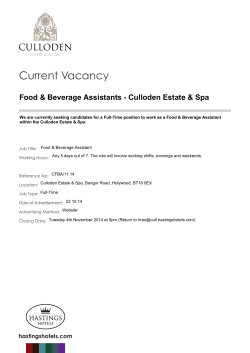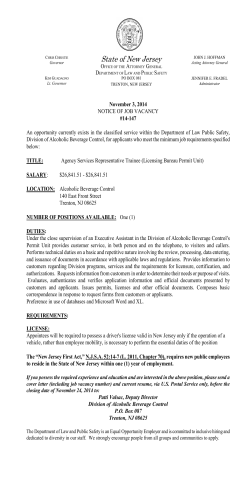
investment opportunities in food and beverage industry
INVESTMENT OPPORTUNITIES IN FOOD AND BEVERAGE INDUSTRY Asia – Africa Summit 2015, Jakarta Indonesia Jakarta Convention Center INTRODUCTION FACTS: Strategic geographic location and strong global presence Abundance of natural resources Total land area Indonesia is around 1.910.931 km² and sea area is around 3.544.744 km² Estimated 250 millions populations, with socio economic level :12% high, 40% medium, 48% low class GDP US$ 3.531,45/capita Dynamic and youthful population (55% < 25 years old) Average expenditure for food per capita 51.08%, in which 12.72% is contributed by processed food 6,435 Km (3 time zone) 2 POTENTIAL RESOURCES Indonesia has the potential of natural resources that comes from agriculture, fishery / marine, livestock, crops and forestry , which can be exploited by the food industry. Some of these natural resources, include : Palm Oil Pepper Cacao Seaweed (30 Million ton) (88 thousand ton) (0,45 Million ton) (0,25 Million ton) No.1 in World No.3 in World No.3 in World No.1 in World Coconut Coffee Fish & Shrimp Tea (3,3 Million Ton) (0,692 MillionTon) (10,5 Million Ton) (0,136 Million Ton) No. 1 in World No. 3 in World No. 2 in World No.5 in World 3 CONTRIBUTION OF FOOD, BEVERAGE AND TOBACCO INDUSTRY IN THE NON OIL AND GAS GDP IN 2013 AND 2014 B. KONTRIBUSI SEKTOR INDUSTRI MAKANAN, Textile , Leather 2013 2014 Textile , Leather Goods and Goods and MINUMAN DAN TEMBAKAU TERHADAP PDB Footwear, 2% Footwear, 7% Wood and Forest INDUSTRI NON MIGAS Wood and Forest Product , 4% Others , Rubber, Rubber Goods and Plastics , 5% Chemical, Pharmacy and Traditional Medicine, 9% Others , 1% Product , 4% 1% Paper and Printing, 4% Food and Beverage , 29% Metal and Electrical Equipment, 11% Food and Beverage , 30% Paper and Printing, 4% Rubber, Rubber Goods and Plastics , 4% Metal and Electrical Equipment, 10% Chemical, Pharmacy and Traditional Medicine, 10% Tobacco, 5% Non‐Metallic Minerals , 4% Tobacco, 5% Non‐Metallic Minerals , 4% Machinery , 2% Machinery , 2% GROWTH of NATIONAL GDP, GDP OF NON ‐ OIL AND GAS INDUSTRY AND GDP OF FOOD AND BEVERAGE INDUSTRY 12% % 10% 8% 6% 4% 2% 0% 2011 2012 2013 2014 National GDP 6.17% 6.03% 5.58% 5.02% GDP of Non ‐ Oil and Gas 7.46% 6.98% 5.45% 5.61% GDP of Food and Beverage Industry 10.98% 10.33% 4.07% 9.54% Year 4 FOOD AND BEVERAGE INDUSTRY INDICATOR Growth (%) base 2010 2011 2012 2013* 2014** 10,98 10,33 4,07 9,54 29,52 Export Value (US$ Billion) 28,90 4,51 4,65 29,01 5,38 29,77 5.51 Import Value (US$ Billion) 6,85 6,16 5,80 5,76 Investment • Domestic Investment (IDR trillion) • Foreign Investment (US$ Billion) 7,94 1,1 11,16 1,78 15,08 2,12 19,59 3,14 66 68 72 71 742.195 884.602 832.411 780.220 Contribution of GDP Non ‐ Oil and Gas Industry (%) Utilities (%) Workforce (People) 5 STRATEGIC ISSUES 1. 2. 3. 4. 5. 6. Need further development of F&B industry to fulfill low consumption beverages product : milk 12.85 lt/cap/y (Ina), 50.9 (Mal), 140 (Swiss) cocoa 0.2 kg/cap/y (Ina), 0.27 (Mal), 8.1 (Swiss) Need to narrowing gap between import and domestic production, such as : sugar, meat and salt. Developing infrastructure to fullfill food safety and quality that refer to Indonesia National Standard (SNI), Good Manufacturing Practices (GMP), Hazard Analysis Critical Control Point (HACCP) and ISO 22000, such as laboratory, certification body, etc. Creating downstream product with a higher value added by further processing agricultural commodities. Developing food ingredient industry to fulfill domestic requirement Improving the productivity of human resources and research & development of food and beverage industry. 6 INVESTMENT INCENTIVES 1. Tax Holiday; based on Ministry of Finance Decree Number 130/2011 (Peraturan Menteri Keuangan Nomor 130 Tahun 2011) and the procedure for application Guidance by Ministry of Industry Decree Number 93/2011 (Peraturan Menteri Perindustrian Nomor 93 Tahun 2011). The Cocoa processing Industry is categorized as renewable resources manufacturing industry that entitled to obtain Tax Holiday Incentives. 2. Tax Allowance: based on Government Decree Number 52/2011 (Peraturan Pemerintah Nomor 52 Tahun 2011) which covers on certain product and industry field only in certain provinces (preferred to North Sumatera, Riau, and West, Central, and East Kalimantan) in form of: – 30% (thirty percent) net tax deduction of the total investment charged for 6 (six) years for 5% (five percent) annually – Accelerated amortization & depreciation – Income tax charged to overseas tax-payer on dividend with the according to the Double Taxation Avoidance Agreement rate of 10% or lower, – Carry forward of losses for longer period but no longer than 10 years 3. Tariff Exemption based on Minister of Finance Decree Number 176/2009 (Peraturan Menteri Keuangan Nomor 179 Tahun 2009) for Capital Goods Importation with the conditions: – Capital Goods which have not been developed in domestic area – Sophisticated Machineries with high license-technology content. – Tariff Exemption valid only for the first 2 (two) years on investment. 7 REMARKS 1. The growth of food and beverage industry, mainly product of "consumer goods“, is predicted to remain stable and always contributes to the biggest share of non oil and gas GDP. It is supported by vigorous domestic demand from the increasing number of middle-class consumers in Indonesia. 2. Huge domestic market will pose a challenge of the entry of similar products from other countries. Therefore, Government along with private sectors should undertake serious efforts to enhance industry competitiveness, such as infrastructure, labor competency and productivity, investment climate and technology, as well as bureaucracy. 8
© Copyright 2025















